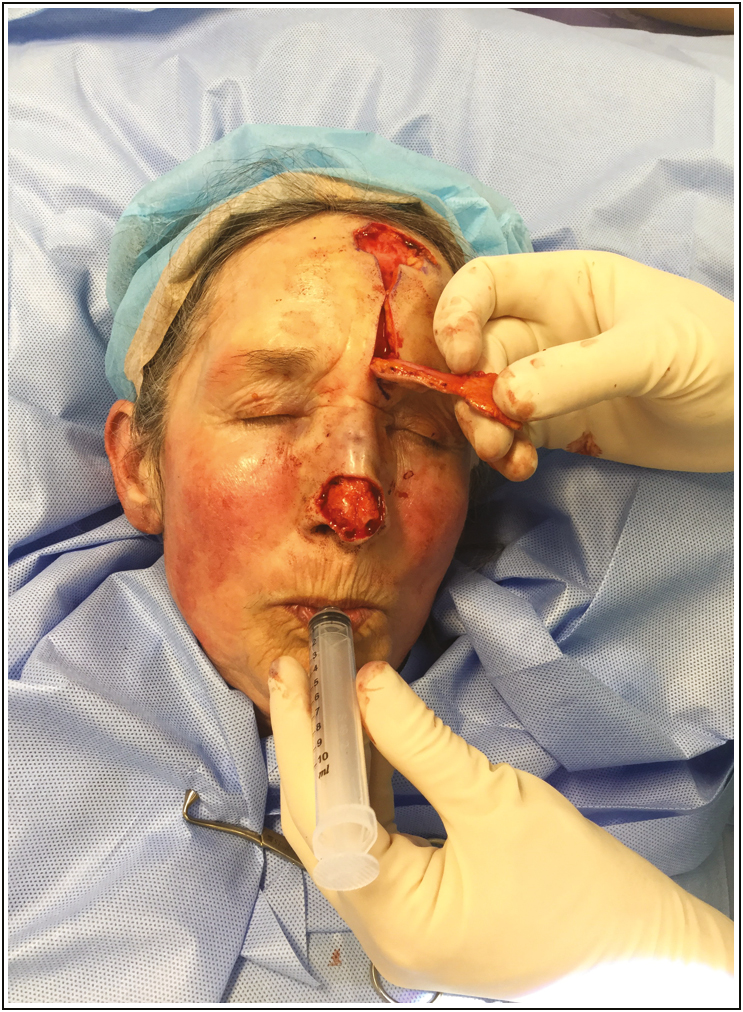Translate this page into:
Valsalva Maneuver to Identify Dermal Bleeders after Paramedian Flap Elevation Under Local Anesthesia
Address for correspondence: Dr. Alistair Campbell Brown, Department of Dermatology, Royal Devon and Exeter NHS Foundation Trust, Exeter, UK. E-mail: Alistair.brown89@gmail.com
This article was originally published by Wolters Kluwer - Medknow and was migrated to Scientific Scholar after the change of Publisher.
Abstract
Abstract
The paramedian forehead flap (PFF) provides a reliable reconstruction option for complex nasal tip defects. The robust blood supply from a well perfused pedicle allows for reconstruction of large defects of the nasal tip for which simpler methods/techniques would provide inadequate coverage or result in inferior cosmesis. A well-designed PFF containing the supratrochlear artery inherently predisposes to small vessel bleeding from the pedicles cut edge. Due to the well perfused nature of the pedicle, there is an increased risk of post-operative bleeding. We describe a technique for better identifying bleeding points from the pedicle to optimise intra-operative haemostasis by performing the Valsalva maneuver using a syringe intraoperatively.
Keywords
Bleeding
complications
hemostasis
surgery
valsalva
INTRODUCTION
The paramedian forehead flap (PFF) provides a reliable reconstruction option for complex nasal tip defects. The robust blood supply from a well-perfused pedicle allows for the reconstruction of large defects of the nasal tip for which simpler methods techniques would provide inadequate coverage or result in inferior cosmesis. A well-designed PFF containing the supratrochlear artery inherently predisposes to small vessel bleeding from the pedicle cut edge. The presence of adrenaline within the subcutaneous tissue can mask the same small vessel bleeding points which, despite meticulous hemostasis can bleed in the immediate postoperative period. The pedicle typically remains in place for two to three weeks prior to division and inset of the flap. Due to the well-perfused nature of the pedicle, there is an increased risk of post-operative bleeding. This risk may be increased further by anticoagulation.
We describe a technique for better identifying bleeding points from the pedicle intraoperatively. Once the flap and pedicle have been elevated and before suturing the flap in place, a sterile 10-mL syringe is placed between the patient’s lips. The patient is then asked to blow firmly through the syringe for 15–20 seconds [Figure 1]. During this maneuver, small bleeding points along the exposed edge of the pedicle become more prominent allowing for easy identification. These can then be treated with gentle bipolar cautery. The maneuver may be repeated if required until no further bleeding points are identified. After suturing the flap in place it is our standard practice to protect the pedicle with yellow-soft paraffin-soaked Atrauman and a hemostatic gauze. We have now performed this technique in a series of ten patients undergoing PFF reconstruction of the nasal tip. No patients have had any complications related to postoperative bleeding from the pedicle since the introduction of the technique.

- Patient showing the technique for Valsalva maneuver using syringe intraoperatively
DISCUSSION
The incidence of postoperative hemorrhagic complications in dermatologic surgery varies significantly between studies due to heterogeneity in the definition. However, a large study of complications following PFF repairs based on ICD-10 codes showed the incidence of postoperative bleeding following PFF to be 1.4%.[1] Post-operative hemorrhagic complications may be associated with an increased risk of complications such as infection and flap necrosis.[2] The importance of these complications is amplified with two-stage procedures such as the PFF.
The Valsalva maneuver was first described by the seventeenth-century Italian anatomist Antonio Valsalva as a mechanism of altering middle ear pressure. It describes forced expiration against a closed glottis after full inspiration. This results in an increase in intrathoracic pressure and a subsequent reduction in venous return. As less venous blood is able to return to the heart, there is an increase in internal jugular venous pressure which in turn causes a reflux of venous blood.[3] The use of the Valsalva maneuver has been advocated in head and neck surgery to identify potential bleeding vessels to allow for intraoperative hemostasis.[4] Potential side effects of the maneuver include hypotension or syncope but the incidence of these is thought to be very low. We have not experienced any complications relating to the use of this technique in our patients.
The Valsalva maneuver is safe and easily performed in the dermatologic setting without the requirement for additional equipment or staffing. Other techniques to increase venous pressure that have been described such as the Trendelenburg technique are not easily achieved in the dermatological setting with an awake patient.[5] The technique could also be performed after recovery from general anesthesia with the exteriorized pedicle. The authors believe that this is the first reported use of the Valsalva maneuver using a syringe to optimize intraoperative hemostasis during PFF reconstruction of a nasal tip defect. In the author’s experience, the number of patients reporting postoperative bleeding in the first 48 h has been significantly reduced since instigating the above intraoperative technique.
Declaration of patient consent
The authors certify that they have obtained all appropriate patient consent forms. In the form the patient(s) has/have given his/her/their consent for his/her/their images and other clinical information to be reported in the journal. The patients understand that their names and initials will not be published and due efforts will be made to conceal their identity, but anonymity cannot be guaranteed.
Financial support and sponsorship
Not applicable.
Conflicts of interest
There are no conflicts of interest.
References
- Postoperative complications of paramedian forehead flap reconstruction. JAMA Facial Plast Surg. 2019;21:298-304.
- [Google Scholar]
- A prospective evaluation of the incidence of complications associated with Mohs micrographic surgery. Arch Dermatol. 2003;139:143-52.
- [Google Scholar]
- Flow volume in the jugular vein and related hemodynamics in the branches of the jugular vein. Ultrasound Med Biol. 2007;33:500-5.
- [Google Scholar]
- Effect of intraoperative valsalva maneuver application on bleeding point detection and postoperative drainage after thyroidectomy surgeries. Int Surg. 2015;100:994-8.
- [Google Scholar]
- Haemostasis in head and neck surgical procedures: Valsalva manoeuvre versus Trendelenburg tilt. Ann R Coll Surg Engl. 2010;92:292-4.
- [Google Scholar]






